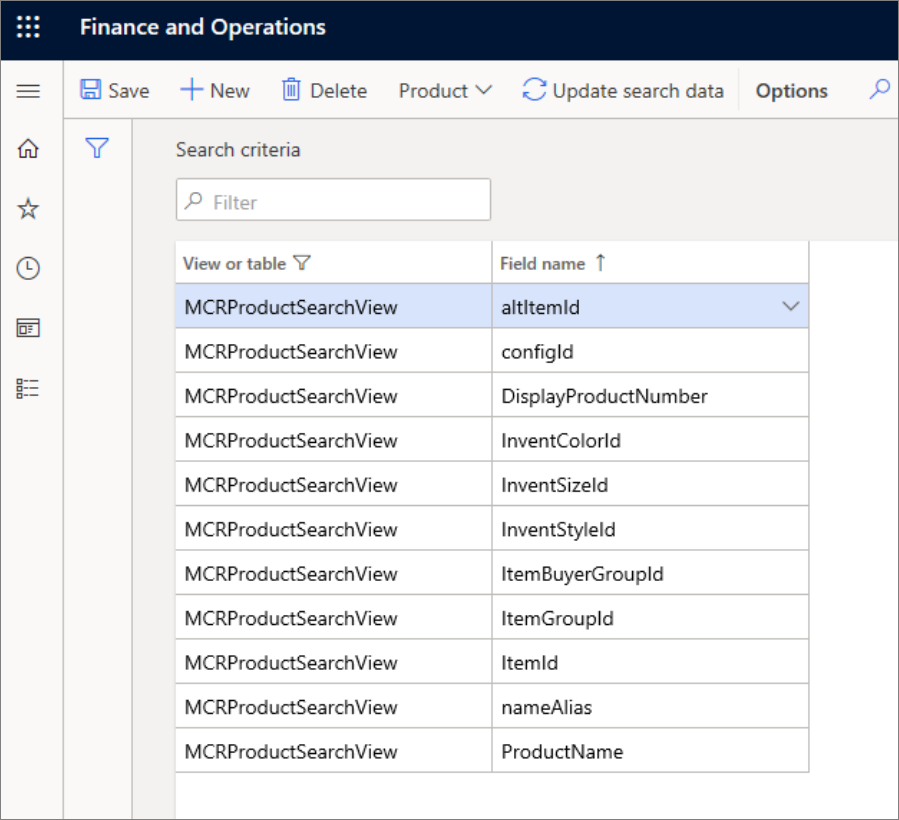Configure customer and item search
Search on keyword is applicable for the three entities of Customer, Product, and Prospect, and requires building up an index table, through the Search criteria page.
Search on predefined fields is only available for Customer and Prospect (when you are creating new documents), which means that the Product search is always based on keyword.
When searching on keyword:
The Full match search uses the SQL CONTAINS method and is highly effective but limited to whole token/phrases.
The Partial match search uses the SQL LIKE method and does not offer optimal performance on large volume data.
When you are searching on predefined fields, both Full and Partial searches use SQL LIKE and are highly effective.
Search for products and product variants during order entry
You can use the Item number field on a sales order line as a search field to search for products and product variants when you manually create a sales order line or a purchase order line.
You can enter any part of a product name, number, or dimension and get a lookup that displays all the items that match the search word. This lets you quickly find product variants when you only have the configuration string or one of the product dimensions available.
Occasionally, having too much of something is not optimal. This theory is especially true if you sell a number of products that are similar and you are trying to remember item numbers or product search names to find the right product to put on a sales order.
When you search for products or product variants, it is important to understand how the search feature finds the products that match the text that you enter.
You can configure the search parameters based on a search type of full or partial match when you are searching for items and/or customers.
The key search rules in delivering search results are:
Search results will return any matching record, disregarding the field that the search text is entered in.
The search text needs to be present in the matching record in its full length.
A match will occur even if the search text is found in the middle of a text string in the matching record. The search text does not have to appear in the beginning of a text string.
The search text is treated as a single text string even if it contains white space.
Configure the product search
Here are the steps to configure the product search.
Step 1
Include all the relevant product and product variant identifiers and dimensions in the search criteria.
Examples of product and product variant identifiers and dimensions that you can search by are Product name, Item number, Display product number, Configuration, Color, Size, Style, Search name, and so on.
Go to Sales and marketing > Setup > Search > Search criteria page. The Search criteria page allows you to define criteria for customer, prospect, and product search. Make sure that you filter the page by using product search criteria, which you can do by switching to Product in the page's menu.

To add the display product number to the search criteria, select New in the page's menu. This selection will add a new record in the Search criteria grid. Open the Field name column lookup and select DisplayProductNumber.
To add the product's configuration to the search criteria, create a new record in the Search criteria grid and select configId in the Field name column. In the same manner, create a record with Field name, InventColorId for the color dimension, InventSizeId for the size dimension, and InventStyleId for the style dimension.
Step 2
Populate the database table that is used for product search.
In the Search criteria page, select the Update search data button.
In the Update search data dialog box, make sure that Source is set to Product and then select OK. The system will aggregate in one table all the selected search criteria that was specified in step 1.
If you have a lot of products and product variants, this operation can be quite lengthy, and you might receive a warning. We recommend that you schedule the search table population on the batch server at a time when the server is not too busy.
Until the table is populated, product search will not provide the correct results. If you do not receive any search results, make sure that this table is populated.
The table must be populated only when the search criteria is modified. Newly released products and variants are automatically added to the table. Deleted products and variants are automatically removed from the table.
Step 3
Enable the lookup for product search on sales and purchase order lines.
You can enable this functionality by going to Sales and marketing > Setup > Search > Search parameters and setting Enable lookup for search to Yes on the General tab.
For sales order line entry, the default behavior is to open the Product search page when you start typing in the Item number field and then press the Tab key.
The Product search page changes the context during order line creation and might be considered unnecessarily intrusive.
If you prefer to get the search results in a lookup and not lose context during order line entry, you can use the search lookup instead. If you search for a product or product variant, but you don't select anything in the lookup and press the Tab key, the Product search page will display.

